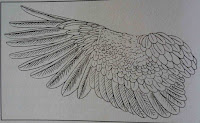So on to the details...
Below are some points to keep in mind when drawing fur or feathers:
- Look closely at the direction of either fur or feather and match your sketching lines to the direction you see.
- They will look much more realistic when the shading lines are drawn at different lengths and sizes
- Use curved lines to draw the form of bird or animal
- Pay close attention to light and shadows as well as texture
Next up are a few guidelines to drawing long or short fur:
Because fur can be straight, curly, soft, coarse, shiny, matte, spotty or stripped...keep these tips in mind when drawing either long or short fur:
- For short fur use short, mostly curved, hatching lines and long, curved hatching lines for long hair.
- Hatching is the perfect shading techniques for almost all furs.
- Bold thick lines give the illusion of thick hair and gentle thin lines crete the illusion of soft fur.
Below is a good example of short, soft, shinny and spotty! Here the direction of the fur helps to define the shape of the dogs head.
And here is a great example of long, soft, wavy. In this picture it’s not the fur that defines the dogs shape but rather the lighting.
Our first exercise was drawing the leg of a cat. It helps identify shadows and fur direction and how they play a part in creating the shape/build of an animal.
 |
| Steps One, Two and Three |
 |
| And steps Four, Five and Six |
 |
| My attempt. Verdict need to work on my patience again! |
Contrast , lighting and texture play huge roles in the drawing of animals. It helps create the illusion of soft, dark or stripped. See the images below to see how you use these techniques to achieve these illusions.
 |
| Contrast of Dark and light helps create softness in the kitty's fur |
 |
| Lighting helps define the mood and furriness of this pooch |
 |
| Texture helps this white swan take shape while contrast allows it to stand out. |
 |
| Steps One and Two |
 |
| Steps Three and Four |
 |
| Steps five and Six |
 |
| Final rendering...Perfect |
 |
| Again with the head.... I think I might have a problem! |
Next is Part 3 of the book - Drawing people.
Chapter 17 starts with the drawing of babies.
(Please note: that photo examples are taken from "Drawing for Dummies by Brenda Hoddinott'' and the above views are not representative of her and are purely based on a 3rd party view being Me! All snippets taken directly from the book are stated as been so)



